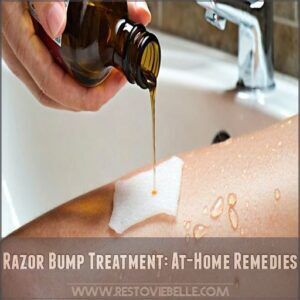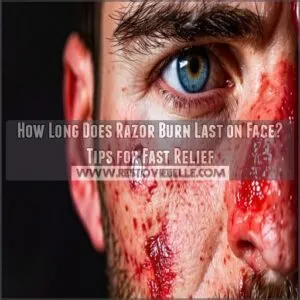This site is supported by our readers. We may earn a commission, at no cost to you, if you purchase through links.
 Witch hazel is your go-to secret weapon for tackling razor bumps.
Witch hazel is your go-to secret weapon for tackling razor bumps.
With its natural astringent properties, it helps reduce the inflammation and irritation caused by those pesky ingrown hairs.
Applying witch hazel cools the skin, providing a soothing relief that can feel like a balm after a fiery shave.
While it won’t magically fix everything overnight, incorporating it into your post-shave routine could make a noticeable difference.
Think of it as your skin’s calming best friend.
Curious to know how it stacks up against other remedies or how to maximize its benefits?
There’s more on that just around the corner.
Table Of Contents
- Key Takeaways
- What Are Razor Bumps
- Does Witch Hazel Help With Razor Bumps
- What is Witch Hazel
- Shaving Tips for Preventing Razor Bumps
- Getting Rid of Razor Bumps and Avoiding Triggers
- Razor Bump Treatment: At-Home Remedies
- Comparing Remedies for Razor Bumps
- Preventing Future Razor Bumps With Witch Hazel
- Using Witch Hazel With Other Ingredients
- Choosing The Best Remedy for Your Skin Type
- Frequently Asked Questions (FAQs)
- Is witch hazel good for razor bumps?
- How do you treat a razor bump in women?
- Does Witch Hazel help with razor burn?
- Is witch hazel good for shaving?
- Should I use witch hazel If I have bumps & pimples?
- Can you put witch hazel on your skin?
- Does witch hazel treat razor bumps?
- Can you put witch hazel on your private area after shaving?
- Is alcohol or witch hazel better for razor bumps?
- Can witch hazel get rid of ingrown hair bumps?
- Is witch hazel suitable for sensitive skin?
- Can witch hazel reduce razor burn severity?
- How often should I apply witch hazel?
- Are there side effects of using witch hazel?
- Can witch hazel help with other types of irritation?
- Conclusion
Key Takeaways
- You’ll find witch hazel a powerful natural remedy for razor bumps, thanks to its anti-inflammatory properties that soothe irritation and reduce redness.
- By applying witch hazel post-shave, you can help tighten pores, minimize swelling, and prevent future ingrown hairs.
- Mix witch hazel with other natural ingredients like tea tree oil or aloe vera for enhanced effectiveness against skin irritation and razor bumps.
- Witch hazel is generally suitable for sensitive skin, but always perform a patch test to avoid any possible adverse reactions.
What Are Razor Bumps
You’ll notice that using a shaving cream rich in moisturizing ingredients like aloe vera shaving cream helps provide moisture and reduce friction. Razor bumps occur when your shaved hair curls back and grows into your skin, causing red, inflamed spots that can be tender to touch.
If you’re experiencing these pesky bumps, you’re not alone, as they commonly appear on the face, legs, and other shaved areas where your body responds to the ingrown hair with inflammation.
Causes and Symptoms of Razor Bumps
If you’ve ever battled those pesky red bumps after shaving, you’re dealing with razor bumps.
They’re also known as pseudofolliculitis barbae (PFB), which often occurs on frequently shaved areas.
These inflamed spots pop up when hair curls back and grows into your skin instead of straight out.
Your body sees this trapped hair as an invader, triggering inflammation.
They’re especially common if you’ve got tightly curled or spiral hair, typically showing up on your face, legs, underarms, or bikini area.
Difference Between Razor Bumps and Razor Burn
Shaving woes often leave us confused about what’s actually causing our discomfort.
While razor burn shows up as an immediate rash from friction or dull blades, razor bumps are those pesky ingrown hairs that pop up days later when hair curls back into your skin.
You can find a variety of products to combat razor bumps, like those sold on a website for witch hazel razor bumps, but it’s important to understand the difference between razor burn and bumps.
Here’s how to tell them apart:
- Razor burn appears right after shaving as red, irritated skin
- Razor bumps develop 2-3 days post-shave as raised bumps
- Burn feels like stinging; bumps feel tender and swollen
- Burns fade quickly; bumps can last weeks without treatment
Does Witch Hazel Help With Razor Bumps
If you’ve ever battled those pesky razor bumps, witch hazel might be your skin’s new best friend.
As a natural anti-inflammatory agent, witch hazel works to cool and tighten your skin while helping to close pores.
Making it an effective solution for both preventing and treating razor bumps.
How Witch Hazel Reduces Inflammation and Irritation
Thanks to its powerful tannins and natural antioxidants, witch hazel tackles inflammation at its source.
When you apply it to razor bumps, these compounds work by constricting blood vessels and proteins in your skin, which reduces redness and swelling.
It’s like having a tiny army of healers that rush to calm angry skin cells, while also helping to dry out any pesky pus-filled bumps.
Benefits of Using Witch Hazel for Razor Bumps
Consistently, witch hazel proves to be a powerhouse for tackling razor bumps and their frustrating symptoms.
You’ll love how this natural remedy transforms your post-shave routine, especially when those pesky bumps show up.
By incorporating a high-quality witch hazel product, such as those found in best witch hazel bumps treatments here, you can take your razor bump prevention to the next level.
- Reduces redness and inflammation within minutes of application
- Shrinks pores to prevent future ingrown hairs
- Fights bacteria that can lead to infection
- Soothes irritated skin without drying it out
What is Witch Hazel
You’ll find witch hazel in many skin care products because it’s a natural plant extract that works as both an astringent and antimicrobial agent.
When you apply witch hazel to your skin, it helps tighten pores and reduce inflammation while fighting bacteria that can cause irritation.
Natural Astringent and Antimicrobial Properties
Witch hazel’s power comes from its natural astringent and antimicrobial properties, which help tighten your skin and fight unwanted bacteria.
Here’s what makes it so effective:
| Property | Skin Benefit | How It Works | Best For |
|---|---|---|---|
| Tannins | Pore tightening | Binds proteins | Oily skin |
| Polyphenols | Anti-inflammation | Reduces swelling | Sensitive areas |
| Antioxidants | Skin protection | Fights free radicals | Regular use |
| Proanthocyanidins | Healing | Repairs tissue | Post-shave care |
Combining Witch Hazel With Other Remedies
While witch hazel works great on its own, you’ll get even better results by combining it with other natural remedies.
Mix it with tea tree oil for enhanced antibacterial effects, or blend it with aloe vera to double down on inflammation relief.
You can also pair witch hazel with coconut oil for extra moisture, or use it alongside hydrocortisone cream for stubborn cases of razor bumps.
Shaving Tips for Preventing Razor Bumps
You’ll find that preventing razor bumps starts with proper pre-shave preparation and the right tools for your skin type.
While witch hazel can help reduce irritation after shaving, combining it with smart shaving techniques will give you the smoothest results.
Exfoliating and Pre-Shave Preparations
Using the right aftershave, such as those with witch hazel that help with razor burn and ingrown hairs, can also make a big difference in your shaving experience. Proper skin prep makes all the difference between a smooth shave and a painful one.
Start by gently massaging your skin with an exfoliating scrub to remove dead cells and lift trapped hairs, which can also help reduce the occurrence of ingrown hairs after shaving.
Next, apply a pre-shave oil to create a protective barrier.
Use a quality shaving brush to lift the hairs and create a rich lather, giving your razor the perfect glide path.
Moisturizing and After-Shave Care
A solid post-shave routine is your skin’s best friend.
After shaving, pat your skin dry gently with a clean towel – no harsh rubbing.
Apply a lightweight, alcohol-free moisturizer to seal in hydration and strengthen your skin barrier.
For extra soothing power, look for products with aloe vera or chamomile.
Follow up with witch hazel to calm any lingering irritation and close those pores.
Choosing The Right Razor for Sensitive Skin
Selecting the right razor is like choosing a dance partner – it’s got to match your moves.
For sensitive skin, single-blade razors are your best friend, as they cut hair at skin level without going too deep.
Safety razors might seem old-school, but they’re gentler than multi-blade options.
If you’re prone to irritation, look for razors with moisture strips containing aloe or vitamin E.
Getting Rid of Razor Bumps and Avoiding Triggers
You can banish those pesky razor bumps with simple remedies like aloe vera gel and coconut oil, while also being mindful of common causes such as shaving too close, and avoiding common triggers such as hot showers and tight clothing.
If you’re dealing with existing bumps, you’ll want to skip shaving over the affected areas and give your skin time to heal naturally.
Aloe Vera and Coconut Oil for Quick Relief
Now that you’ve got your shaving routine down, let’s tackle those pesky razor bumps with nature’s finest remedies. Both aloe vera and coconut oil pack a powerful punch against irritation and inflammation.
Here’s what these natural healers can do for your skin:
- Aloe vera’s enzymes reduce redness and swelling within minutes
- Coconut oil’s antibacterial properties fight potential infections
- Both ingredients create a protective barrier for healing
- They work together to speed up skin recovery
- You’ll get instant cooling relief from the burning sensation
Avoiding Hot Showers and Tight Clothing
Like a cozy blanket, hot showers might feel comforting, but they’re actually your skin’s worst enemy after shaving.
The heat can intensify inflammation and make razor bumps more pronounced.
You’ll want to stick to lukewarm or cool water instead.
As for your wardrobe choices, skip those ultra-tight clothes for a few days – they’ll rub against your freshly shaved skin and worsen irritation.
Refraining From Shaving Over Bumps
Along with avoiding hot showers and tight clothes, it’s smart to press pause on shaving when you’ve got razor bumps.
Think of your skin like a garden – you wouldn’t mow over wilted plants.
Using witch hazel for razor bumps can also help soothe and calm the skin.
Shaving irritated areas can lead to cuts, infection, and more intense inflammation.
Instead, give those bumps 2-3 days to heal naturally while using witch hazel or aloe vera for relief.
Razor Bump Treatment: At-Home Remedies
You’ll find effective relief from razor bumps using simple items you already have at home, from soothing cold compresses to anti-inflammatory treatments.
Whether you’re dealing with mild irritation or stubborn ingrown hairs, these proven remedies can help calm your skin and speed up the healing process.
Cold and Warm Compresses
When razor bumps flare up, temperature therapy can be your best friend.
Start with a cold compress for 10-15 minutes to reduce swelling and numb the area.
You can also use witch hazel pads, like those found at witch hazel products, to help soothe the skin and reduce inflammation.
After the initial inflammation calms down, switch to warm compresses – they’ll help relax the skin and coax those trapped hairs to the surface.
Just remember to keep the compresses clean and never apply ice directly to your skin.
Hydrocortisone Cream and Aluminum Acetate Solution
Hydrocortisone cream, your medicine cabinet’s secret weapon, tackles razor bump inflammation head-on.
To prevent razor bumps from forming in the first place, consider shaving with a sharp blade to minimize friction and irritation.
Apply a thin layer of 1% hydrocortisone cream directly to affected areas up to twice daily.
For an extra boost, try aluminum acetate solution – it’s particularly effective when used as a compress. Mix one packet with 8 ounces of water, soak a clean cloth, and gently press it against irritated skin for 15-20 minutes.
Colloidal Oatmeal Baths and Cooling Patches
Beyond hydrocortisone creams, two gentle solutions stand out for razor bump relief.
Colloidal oatmeal baths work wonders – just soak for 10-15 minutes daily to reduce inflammation and soothe irritated skin.
For quick comfort on the go, cooling patches offer instant relief by bringing down redness and calming angry bumps.
You’ll find both options particularly helpful if you’ve got sensitive skin that needs extra TLC.
Comparing Remedies for Razor Bumps
You’ll find several effective remedies for razor bumps, from witch hazel to aloe vera and tea tree oil, each offering unique benefits for your skin.
Witch hazel works as an anti-inflammatory astringent that tightens pores.
Other options like hydrocortisone cream and natural oils target specific concerns such as redness and bacterial growth.
Aloe Vera Vs Witch Hazel for Razor Bumps
Between aloe vera and witch hazel, you’ll find two powerful allies in your fight against razor bumps. While both reduce inflammation, they work differently. For those experiencing razor bumps due to ingrown hairs that grow back into the skin, causing inflammation and bumps, it’s worth noting that similar inflammation can also cause edge thinning, which can be addressed by learning how to prevent edge thinning. For those experiencing razor bumps due to ingrown hairs that grow back into the skin, causing inflammation and bumps, treating razor bumps is important.
- Witch hazel tightens pores and calms redness immediately
- Aloe vera’s enzymes speed up healing and reduce swelling
- Witch hazel dries excess oil and prevents infection
- Aloe vera creates a protective barrier and moisturizes
For best results, try using witch hazel right after shaving, followed by aloe vera before bed.
Tea Tree Oil Vs Witch Hazel for Ingrown Hairs
Both tea tree oil and witch hazel pack a powerful punch against ingrown hairs, but they work differently.
Tea tree oil’s antimicrobial properties target bacteria that can cause infection, while witch hazel’s astringent qualities help tighten the skin and reduce inflammation.
You’ll get the best results by combining them – just mix a few drops of tea tree oil into your witch hazel toner for a double-duty treatment.
Hydrocortisone Cream Vs Witch Hazel for Redness
So, you’ve got redness from razor bumps—which remedy reigns supreme?
Hydrocortisone cream directly tackles inflammation, offering quick redness relief.
Witch hazel, a natural astringent, soothes and reduces irritation.
For best results, consider your skin type; some find witch hazel gentler.
It’s all about finding what works best for your bumps!
These ingredients to compare offer at-home treatments.
Preventing Future Razor Bumps With Witch Hazel
Incorporating witch hazel into your shaving routine can help reduce the risk of future razor bumps.
By using this natural remedy, you can soothe your skin and maintain its health after every shave.
Incorporating Witch Hazel Into Your Daily Routine
Including witch hazel in your skincare routine can be simple and effective.
Whether you’re a morning or night owl, here’s how:
- Witch hazel toner: Apply after cleansing to shrink pores and soothe skin.
- Daily routine: It balances oil without stripping moisture.
- Evening routine: Use it before bed for overnight skin calm.
Shaving Tips for Reducing Razor Bumps
When aiming to reduce razor bumps, a good shave is like baking a cake—follow the steps.
Start with an exfoliation routine to prep your skin, a dab of pre-shave oil adds protection, and always shave in the direction of hair growth.
Use a sharp razor blade for a clean finish.
Using Witch Hazel With Other Ingredients
When you’re looking to enhance the soothing effects of witch hazel on razor bumps, combining it with other ingredients like tea tree oil or Aloe Vera can be beneficial.
It’s important to understand how these mixtures work and what precautions to keep in mind for the best results.
Mixing With Tea Tree Oil and Aloe Vera
Ever tried mixing witch hazel with tea tree oil and aloe vera? This combo is a great defense against skin irritation and razor bumps, offering some impressive benefits.
- Tea tree oil benefits: Tea tree oil can be used to promote hair growth by improving blood flow to hair follicles. Antimicrobial and soothing.
- Aloe vera benefits: Calms and hydrates.
- DIY recipe: Combine equal parts.
- Mixing ingredients: Easy and effective.
- Skin irritation: Gently managed.
Combining With Hydrocortisone Cream
Blending witch hazel with hydrocortisone cream might boost their powers against razor bumps.
Witch hazel’s knack for reducing inflammation complements the cream’s inflammation-busting abilities.
They could form a dynamic duo for calming irritated skin.
It’s about team play!
Apply a small amount of each and see how your skin reacts to this soothing blend.
Precautions and Possible Interactions
Before mixing witch hazel with other products, check the product ingredients for potential interactions.
A patch test is your best friend; it helps you avoid a surprise reaction.
Some folks have witch hazel allergies or skin sensitivity.
If you’ve got sensitive skin, start slow with a diluted mixture.
Remember, safety first!
Choosing The Best Remedy for Your Skin Type
Selecting the right remedy for razor bumps depends on your skin type, whether it’s sensitive, oily, or dry.
Understanding how your skin reacts to different ingredients helps you choose the most effective treatment.
Sensitive Skin and Witch Hazel
Witch hazel’s natural properties work wonders on sensitive skin, helping calm redness and itchiness like a gentle hug for your face. Here’s how you can use it effectively:
- Apply witch hazel for eczema and rosacea relief, reducing inflammation without harsh chemicals.
- Choose witch hazel for dryness, offering hydration against irritation.
- Soothe acne and redness, supporting clearer, calmer skin.
Oily Skin and Razor Bumps
Dealing with oily skin and razor bumps can feel like an uphill battle.
You’ve got to juggle oil control while reducing irritation.
Incorporate witch hazel into your skincare routine; it’s a natural astringent that tightens pores.
Pair this with a salicylic acid-based shaving product to help manage oil and prevent ingrown hairs.
Your skin will thank you!
Dry Skin and Ingrown Hairs
Having oily skin affects razor bumps, but when dry skin gets in the mix, ingrown hairs become pesky partners.
Keep it smooth with a shaving routine that respects your skin’s delicate nature.
Moisturizer is your best friend—don’t skimp on it.
Try regular, gentle exfoliation to prevent those stubborn hairs from hiding out beneath dry patches.
Frequently Asked Questions (FAQs)
Is witch hazel good for razor bumps?
Did you know that roughly 80% of people who shave experience razor bumps?
Yes, witch hazel’s anti-inflammatory properties can soothe irritated skin and help prevent those pesky bumps.
It’s a natural remedy worth trying!
How do you treat a razor bump in women?
To tackle razor bumps, gently apply aloe vera for soothing, or use witch hazel to calm irritation.
Avoid shaving over bumps, wear loose clothing, and consider a hydrocortisone cream for inflammation.
Always shave with the grain.
Does Witch Hazel help with razor burn?
Ever tried soothing a sunburn with aloe vera?
Witch hazel acts similarly for razor burn, offering a cooling relief.
Its anti-inflammatory properties calm irritated skin and help reduce redness, making it a handy addition to your routine.
Is witch hazel good for shaving?
Witch hazel’s anti-inflammatory properties make it great for shaving.
Applying it post-shave, much like using home remedies for razor burn, helps soothe irritation, tighten pores, and prevent razor bumps.
It’s like giving your skin a calming high-five after the blade’s dance!
Should I use witch hazel If I have bumps & pimples?
Definitely use witch hazel for bumps and pimples!
Its anti-inflammatory properties help soothe and heal your skin.
Apply it after shaving or cleansing to reduce irritation and redness.
It’s gentle and can be used daily.
Can you put witch hazel on your skin?
You can apply witch hazel on your skin for soothing effects.
It’s an anti-inflammatory that calms irritation and tightens pores.
Just dab it gently with a cotton pad and let your skin feel the relief.
Does witch hazel treat razor bumps?
Think of your skin as a canvas; witch hazel, a gentle artist’s touch.
It’s an anti-inflammatory, so it can soothe irritated skin and calm razor bumps.
It helps reduce redness and inflammation, promoting healing.
Can you put witch hazel on your private area after shaving?
Applying witch hazel to your private area after shaving can help soothe and calm the skin thanks to its anti-inflammatory properties.
Just make sure to use alcohol-free witch hazel to avoid irritation and dryness.
Is alcohol or witch hazel better for razor bumps?
Imagine your skin as a garden.
Witch hazel, a natural healer, soothes razor bumps like aloe to sunburn.
Unlike alcohol, it calms without stinging.
Opt for witch hazel for gentle relief and prevention.
Can witch hazel get rid of ingrown hair bumps?
Yes, witch hazel can help reduce ingrown hair bumps.
Its anti-inflammatory properties soothe irritation, calm your skin, and assist in healing.
Regular use may prevent future bumps, offering relief and smoother skin post-shave.
Is witch hazel suitable for sensitive skin?
Witch hazel is generally suitable for sensitive skin as it has anti-inflammatory properties that soothe irritation.
Always do a patch test first to make sure it doesn’t cause any adverse reactions or sensitivity on your skin.
Can witch hazel reduce razor burn severity?
Razor burn may have met its match—witch hazel.
This anti-inflammatory superhero doesn’t need a cape.
It calms irritated skin post-shave, soothing redness and tightening pores, giving your skin that sigh of relief it desperately needs.
How often should I apply witch hazel?
Apply it twice daily, after showering and before bed.
Don’t overdo it; a little goes a long way.
Let your skin breathe between applications.
Consistent use is key for best results.
Are there side effects of using witch hazel?
Imagine a wise owl, watching for side effects—it knows keeping skin safe is key.
Witch hazel might dry your skin if overused or cause allergic reactions in sensitive skin, so a patch test is smart.
Can witch hazel help with other types of irritation?
You can use witch hazel to soothe other skin irritations, like minor cuts or insect bites.
Its anti-inflammatory and astringent properties calm and tighten the skin, providing relief and reducing redness.
It’s a handy natural remedy!
Conclusion
Think of witch hazel as nature’s toolbox for tackling razor bumps.
While razor bumps can be a nuisance, witch hazel offers relief through its natural soothing properties.
It effectively reduces inflammation and irritation, making it a valuable addition to your routine.
Add witch hazel into your post-shave care to experience smoother skin and fewer bumps.
By using witch hazel, you can say goodbye to the discomfort of razor bumps and hello to happier, healthier skin.

















